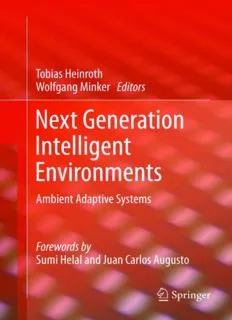
Next Generation Intelligent Environments: Ambient Adaptive Systems PDF
Preview Next Generation Intelligent Environments: Ambient Adaptive Systems
Next Generation Intelligent Environments Tobias Heinroth • Wolfgang Minker Editors Next Generation Intelligent Environments Ambient Adaptive Systems Editors Tobias Heinroth Wolfgang Minker Institute of Information Institute for Information Technology Technology University of Ulm University of Ulm Albert-Einstein-Allee 43 Albert-Einstein-Allee 43 89081 Ulm 89081 Ulm Germany Germany [email protected] [email protected] ISBN978-1-4614-1298-4 e-ISBN978-1-4614-1299-1 DOI10.1007/978-1-4614-1299-1 Springer New York Dordrecht Heidelberg London Library of Congress Control Number: 2011936128 ©SpringerScience+B usinessMedia,LLC2011 All rights reserved. This work may not be translated or copied in whole or in part without the written permission of the publisher (Springer Science+Business Media, LLC, 233 Spring Street, New York, NY 10013, USA), except for brief excerpts in connection with reviews or scholarly analysis. Use in connection with any form of information storage and retrieval, electronic adaptation, computer software, or by similar or dissimilar methodology now known or hereafter developed is forbidden. The use in this publication of trade names, trademarks, service marks, and similar terms, even if they are not identified as such, is not to be taken as an expression of opinion as to whether or not they are subject to proprietary rights. Printedonacid-freepaper Springer is part of Springer Science+Business Media (www.springer.com) Foreword I Recent advances in Intelligent Environments research give a glimpse into the fu- ture of our planet and reveal exciting visions of smart everything – smart cities, smarthomes,smartworkplaces,smarthotels,smartschools,andmuchmore.Driven by technological evolution offering low power many-things and wireless almost- everything(e.g.,IEEE802.15.4radio,wirelesssensornetworks,sensorplatforms), wecould,inonlyadecade,envisionandprototypeimpressivecyber-physicalsys- tems and applications. In most of these systems, the goal has been clear and con- vincing,andthetechnologyprovedtobepromisingandexciting. Butprototypingisonlyabeginning,andmuchremainstobeinnovatedanddone beforesuchIntelligentEnvironments(IE)becomecommonplaces.Manyresearch disciplines must collaborate among and within themselves, including domain ex- perts (of the particular environment, e.g., gerontologist for assisted living spaces), behaviourscientists,engineers,computerscientists,tomentionjustafew.Collabo- rationwithinthecomputerscienceandengineeringdisciplineiskeytothesuccess ofIE.Systemssupportandmiddlewareareessentialfoundationtobuildinganysys- tems–IEarenoexception.Softwareengineeringisurgentlyneededtounderstand andsupportthefulllife-cycleofIE.Newprogrammingmodelsarealsoneededfor developing safe and adaptive applications and services. New notions of trust must be formulated and supported to ensure symbiotic relationship between the users and their environments. Understanding human computer interaction is crucial and in some environments, affecting persuasion is of paramount importance. But this isnotall.Withoutmachinelearningandcomputationalintelligencetechniques,the potentialutilityand“ceilingofgoals”ofIEwouldbeseverelylimited. “NextGenerationIntelligentEnvironments”providesanexcellentcompendium ofcollaborativeresearcheffortsinsupportofambientecologiesorchestratedwithin a mega project funded by the European Community – The Adaptive and TRusted AmbienteCOlogies(ATRACO). The book goes beyond prototypes and addresses the fundamental generalities andnecessaryecologiesthatcanleadtobetterdesign,development,operationand adaptation of IE. The book covers many important areas of collaborative research within computer science and engineering, including system support and middle- v vi ForewordI ware,appliedknowledgeandontology,userinteractions,artificialintelligence,user experience and much more. The coverage is unique in that all chapters are inter- relatedandaligned,showingkeydependenciesandthemes.Oneoverarchingtheme isadaptationthatappearsinmanychaptersaddressingtheenvironmentitselfaswell astheuserandtheirinteractions. ItisgratifyingtofinallyseeabookcontributedtotheIEresearchcommunitythat bringsunprecedenteddepthinthetreatmentofsuchdelicatelyinterdependenttopics thatmakeupthecoreareasofIE.Itisatimelyandamuchneededcontributionthat will help shape the curricula in emerging smart systems specialities and programs aroundtheworld. Gainesville(USA),February2011 SumiHelal Foreword II Technologicaladvanceshavebeenshapingourworldforcenturies.Thebelievethat technologyisbeneficialtohumankindhasdeeprootsinoursocieties,sinceinitial technologicaldevelopmentswerecloselylinkedtosurvivalconditionslikehunting andbuilding.Nowadaystechnologyisarounduseverywhereandthelivesofmost ofhumanityhavebecomecloselyintertwinedwithmoreorlessintensity. Many western societies are at this point in history investing on technology that canpervadealllevelsofdailylifetoassisthumansintheiractivities,whetherthis isathome,attheoffice,atschoolorshopping.Theideaisthatthereistechnology alreadyavailablethatcanhelpidentifyingsomesituationswherehumansneedhelp and also to deliver some of that assistance, in a more or less automated way. This hasledtotheideathatwecancreate“IntelligentEnvironments”whichcanactively pursuebenefitsforthehumanswhoinhabitsthoseenvironments. This is no trivial enterprise. Technology can fail. Humans are complex beings. Weliveinadynamicworldandsituationscanchangesubstantiallyinshortperiods of time. The engineering of such systems require the careful blending of cutting edgetechnologyandexpertise.PreviousadvancesinComputerScience,Engineer- ing, Architecture, Social Sciences and other areas are supporting the development ofanewgenerationoftechnologicaldevelopmentswhichareaimingathelpingyou whereveryouare.Sofarhumanshavetoinvestsubstantialefforttounderstandhow to interact with a computer and benefit from it. This technology aims at bringing benefitstohumanwithoutdemaningaspecifictechnologicalexpertisefromthehu- man. The advances provided by the ATRACO project are a good example of a well rounded solution which provides a dynamic middleware and adaptive networking architecture which can facilitates the creation of Intelligent Environments making availableadynamicrangeofservices.Intelligentadaptationoftheenvironmentand flexible interaction with humans complete a technological solution which adapts to context and situations to be most useful. Another important contribution of this project is that these technologicaladvances are designed with ethical principles in mind. vii viii ForewordII Surelythiswillnotbethelastwordinthearea.Humansseemtohavedeveloped aninsatiableappetitefortechnologicaldevelopmentsthatcanpotentiallymaketheir liveseasier.Whetheryoujustbecomeinterestedondoingseriousworkinthisarea or you want to keep yourself updated in the latest developments that help you to designtheworldoftomorrowthisbookisagoodplacetostarttogetengagedwith thisdevelopmentwhichcanshapeourworld. Jordanstown(UK),February2011 JuanCarlosAugusto Preface This book is based on the work that has been conducted within the ATRACO (AdaptiveandTRustedAmbienteCOlogies)project1aspartoftheEuropeanCom- ◦ munity’s 7th Framework Programme (FP7/2007-2013) under grant agreement n 216837. The aim of ATRACO project is to contribute to the realization of trusted ambientecologies.Interactiveappliances,collaborativedevices,andcontextaware artefacts, as well as models, services, software components are parts of ambient ecologies.Acontext-awareartefact,applianceordeviceusessensorstoperceiveits context of operation and applies an ontology to interpret this context. It also uses internaltrustmodelsandfuzzydecisionmakingmechanismstoadaptitsoperation tochangingcontext.Finally,itemploysadaptivedialoguemodelstocommunicate itsstateandinteractwithpeople. Ambient ecologies form the infrastructure that supports user activities. In AT- RACO, each activity is modelled as a “bubble” using finite resources to achieve thegoalsofitsownerandhavingclearlymarkedborders,whichrealizetheprivacy requirements. The user tasks that compose an activity are supported by an ad-hoc orchestration of ubiquitous computing services, which are manifested via an ecol- ogyofsmartartefacts.Thebubbleadaptstodifferentcontextsbyre-negotiatingits borders,adoptingsuitableinteractionmodesandemployingresourcemanagement models. InATRACO, adaptation will beresearched in termsof artefact operation, ecologycomposition,networkelectionandman-machineinteractionwithrespectto usercontextandbehaviour. The book edition consists of eight chapters each covering a detailed look on a specificscientificareawithinthefieldofIntelligentEnvironments.Thefirstchap- ter describes a middleware architecture that has been developed for the ATRACO prototype.Thesecondchapterdealswiththenetworkingaspects,whicharecrucial withinthecontextofambientintelligentsystems.Thethirdchapterprovidesade- tailedinsightintoonthetheoreticalandthepracticalapproachestoontology-based knowledge management. Chapter 4 presents one of the most important adaptation mechanism used within ATRACO realized as advanced fuzzy mechanism. Chal- 1http://www.uni-ulm.de/in/atraco ix
Description: